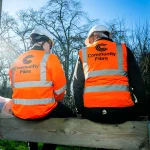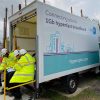Openreach Win UK Project Gigabit Broadband Contracts and Help 312k Premises

The Government claims to have kicked off a “renewed push” today to “reach full gigabit [broadband] coverage by 2030“, which they’ve done by announcing that Openreach (BT) has secured several contracts under the £5bn Project Gigabit scheme. This could eventually be worth up to £800m (state aid) and may upgrade 312,000 premises in remote rural areas of Scotland, England and Wales.
Project Gigabit has been running for the past few years and aims to extend networks capable of delivering download speeds of 1000Mbps+ (1Gbps) and uploads of 200Mbps+ to 85% or more of UK premises by the end of 2025 (it’s currently c.84%), before rising to “nationwide” coverage (c.99%) by around 2030 (here). But commercial builds are delivering most of this, while public money remains focused on the final 10-20% of poorly served premises.
Most of the related contracts (Type A – Local scale and Type B – Regional scale) under Project Gigabit’s Gigabit Infrastructure Subsidy (GIS) scheme have already been awarded for much of England. All of these have gone to smaller alternative networks (altnets) like Cityfibre, GoFibre, Wessex Internet, Gigaclear and various other providers.
Advertisement
However, the project has also had to create a number of Cross-Regional (Type C) procurements, which were focused on areas where no or no appropriate market interest had been expressed before to the Government’s umbrella Building Digital UK (BDUK) agency, or areas that have been descoped or terminated from a prior plan.
Such areas are often skipped due to being too expensive (difficult) for smaller suppliers to tackle. Due to this Type C’s can only really be delivered by operators of some scale and are intended to cover a much wider area. Back in May 2024 we revealed that Openreach (BT) had been named as the preferred bidder for all of these (here) and thus today’s announcement is the logical outcome of that.
What’s been awarded?
The official announcement is a bit generalised, but it states that “up to” £800 million in government investment will be made available to modernise broadband infrastructure for 312,000 premises in rural areas of England, Scotland and Wales as part of the new deal with Openreach. Just to be clear, this figure was first stated for Type C procurements back in 2022 (here) and forms part of the overall budget for Project Gigabit.
However, it’s important to stress that Openreach hasn’t yet won all of the Type C procurements (it’s just a matter of time), thus the figure of 312,000 premises and £800m being headline today is more a reflection of what they’re expected to secure over the coming months. Instead, today’s announcement only confirms that Openreach have secured the first two out of six Type C contracts.
Advertisement
The deal today means that premises in remote areas of Britain, such as the South Wales Valleys, Exmoor National Park and the Forest of Bowland will finally gain access to gigabit broadband. This is also the first time that Wales, the nation with the lowest percentage of gigabit coverage, will benefit from this programme.
Today’s Contract Awards for Openreach
Type C (Call Off 1): Lancashire (Lot 9C), North Wiltshire and South Gloucestershire (Lot 30C) , West and Mid -Surrey (Lot 22C), Staffordshire (Lot 19C), West Berkshire (Lot 13C) and Hertfordshire (Lot 26C)
Premises: 57,100 * (final contracted 54,300)
Value: £149.7mType C (Call Off 2): West and North Devon (Lot 6C) , North West Wales, Mid Wales (Lot 43C) and South East Wales (Lot 44C)
Premises: 47,100 * (final contracted 42,200)
Value: £139.1m* The figures above are from Project Gigabit’s April 2024 estimate and thus the final contract details are slightly different.
According to today’s announcement, both contracts – worth £288 million – have been signed with Openreach and aim to connect approximately 96,600 homes and businesses in England and, for the first time, Wales. This is slightly less than the originally forecast total of both contracts (c.104,000 premises). In any case, the first premises under these contracts are anticipated to have access to gigabit-capable broadband in “early 2025“.
Take note that Call Off 2 will benefit parts of the following constituencies in Wales: Arfon, Clwyd South, Dwyfor Meirionnydd, Ceredigion, Montgomeryshire, Brecon and Radnorshire, Monmouth, Torfaen, Newport West, Caerphilly, Blaenau Gwent, Cardiff North, Cardiff Central, Cardiff West, Cardiff South and Penarth, Merthyr Tydfil and Rhymney, Ogmore, Islwyn, Pontypridd, Cynon Valley, Rhondda, Vale of Glamorgan, Bridgend, Neath, Aberavon, Swansea East, Swansea West, Gower.
Peter Kyle, Secretary of State for DSIT, said:
“Over the past decade, the UK’s broadband rollout has clearly not happened fast enough and has overlooked too many areas, especially in Scotland and Wales. Robust digital infrastructure is essential for growth, productivity and competitiveness and this shortfall not only poses risks to our economic stability, but also entrenches existing inequalities across the country.
We are fixing this by delivering for hundreds of thousands of homes and businesses up and down the country, focusing on the areas that were not prioritised by the previous government, such as Wales.
Today marks a significant milestone in delivering on our promise to redouble our efforts to achieve full gigabit coverage by 2030 and lay the foundations for a more inclusive, dynamic and prosperous future for all citizens.”
Clive Selley, CEO of Openreach, said:
“Research shows that full fibre provides a host of economic, social and environmental benefits – and I believe we’re the best in the business at delivering it. I’m proud we’ve been chosen, through a fiercely competitive process, and we’re already cracking on with the job.
This is a British infrastructure success story. Our network already reaches more than 15 million urban and rural premises and, wherever we build, we bring the widest choice of providers for customers. I’m confident we can reach as many as 30 million homes by the end of the decade if the conditions remain supportive.”
Jo Stevens, Secretary of State for Wales, said:
“At the moment we have too many people, especially in the more remote areas, of Wales who can’t properly access the online world, and I’m pleased that thanks to this substantial investment from the UK Government work, on fixing that is starting now.”
Talks are now said to be “underway with Openreach to agree further contracts” to benefit around 215,800 more premises across England, Scotland and Wales, with more announcements expected in the “coming months“. This reflects the following ongoing Type C procurements.
Advertisement
Remaining Type C Procurements
Type C (Call Off 3): East and South Shropshire, North Herefordshire, North Wales, and South West Wales
Est. Premises: 49,600
Est. Value: £136.1mType C (Call Off 4): Mid Devon, North Somerset, and South Devon
Est. Premises: 23,300
Est. Value: £69.8mType C (Call Off 5): Essex and North East England
Est. Premises: 22,100
Est. Value: £61.3mType C (Call Off 6): Central and North Scotland
Est. Premises: 96,900
Est. Value: £207.4m
In terms of Wales specifically, the government says this means that – once all the related Type C contracts have been awarded – a total of around £170m of public money will go toward extending gigabit-capable broadband to benefit around 70,000 hard-to-reach Welsh homes and businesses. But the exact details of Call Off 3 – 6 won’t be known until they’ve been officially awarded, which is expected by around the end of this year.
The announcement builds on work already underway through other Project Gigabit contracts to build faster networks for up to 910,000 hard-to-reach premises across England. Dozens of contracts representing more than £1.9bn worth of public investment have now been signed with 11 suppliers to deliver the upgrades.
However, the new Government is perhaps being a bit disingenuous in parts of this announcement, such as by claiming that this is all part of Labour’s pre-election commitment to “make a renewed push to fulfil the ambition of full gigabit and national 5G coverage by 2030” (here). But much as we said above, there’s nothing particularly new about today’s announcement, which has been in the pipeline since well before the election.
UPDATE 7:03am
We’ve updated some of the totals with the final contracted figures for call-off 1 and 2 above. In addition, Openreach successfully bid for these to adopt the single supplier framework (here), which means any future fibre build delivered through the framework doesn’t have to go through another competitive process each time (i.e. later extension projects and infill in these areas will be easier to agree). You can see a rough image of the related build for each area below:
- Call-off 2 – South East Wales (Lot 44C)
- Call-off 2 – North West and Mid Wales (Lot 43C)
- Call-off 2 – West and North Devon (Lot 6C)
- Call-off 1 – North Wiltshire and South Gloucestershire (Lot 30C)
- Call-off 1 – Hertfordshire (Lot 26C)
- Call-off 1 – West and Mid Surrey (Lot 22C)
- Call-off 1 – Staffordshire (Lot 19C)
- Call-off 1 – West Berkshire (Lot 13C)
- Call-off 1 – Lancashire (Lot 9C)
Mark is a professional technology writer, IT consultant and computer engineer from Dorset (England), he also founded ISPreview in 1999 and enjoys analysing the latest telecoms and broadband developments. Find me on X (Twitter), Mastodon, Facebook, BlueSky, Threads.net and Linkedin.
« Freedom Fibre Top 20k FTTP Customers in North West and West Midlands























































6 years to wait – feel pain for those waiting so long!
Hopefully they’ll deliver all they’ve agreed to do and not walk away from bits they decide are too difficult or expensive.
Mark, any idea of timeline for the remaining call off area’s? Particularly Call Off 5
Surely by this stage the intervention area’s are well and truly identified as there have been many, many open market reviews and rolling reviews completed.
As said in the article, they’re due to be awarded to Openreach by around the end of 2024. The official estimate is Nov 2024, but I always allow 2-3 months of leeway on those dates. We should get an updated viewpoint any day now with the next Project Gigabit progress update.
Atleast some progress in these type c contracts, it’s good that it’s finally been delivered and hopefully in full by the end of the year. I really prefer the type a/b contracts that are smaller and easier for altnets to apply for but that been said good stuff so far. I do quibble with the labour response, labour is simply continuing the process that last government started and budgeted while commendable that they did not cancel it, they did not add additional money than the previous government so they cannot take so much credit.
These were areas where the altnets wouldn’t bid because apparently not economically viable. My village in West Berkshire is a “victim” of this. Half the village is on Gigaclear as they were able to drop a POP outside each house they passed on the way to outlying properties in phase 1, but weren’t allowed to “overlay Openreach VDSL”. Even though there is a Gigaclear ring and hub in the village they wouldn’t extend (probably because of hard dig as much as anything), so a good chunk of this village have been waiting for Superfast Broadband for years now.
The FTTP rollout has been strange as far as rollouts go, we keep being given the impression that rural areas need these contracts, but many villagers consistently report they have at least 2 FTTP networks in their village, as well as small towns, and at the same time we have city areas with no FTTP coverage but no government scheme to get them coverage. These areas get almost no press coverage, I think only Hyoperoptics has mentioned them, and Youfibre have spoken out about the problem of government funding going to rural areas which have commercial rollouts.
All well and good, although the pace that these contracts are delivering at is very disappointing. CityFibre in Hampshire for example have said nothing about Test Valley/northern Hampshire since being awarded the contract.
Also don’t understand why they can’t provide more detailed maps for the offer scope and final contract scope. These silly low resolution screen grabs are very annoying.
Or Winchester…
Yes, non-useless BDUK maps and a project plan would help allow the public to see what and when they are getting for their money.
Commercial sensitivity had put paid to that.
So, how can we tell if these projects are good value for the taxpayer and deliver better broadband in the most efficient manner to those that need it ?
Well, a retrospective evaluation some years hence seems about he best we can hope for.
Well, back-slapping and trebles all round then.
The reality is the rural communities affected by this announcement will have no idea when service will eventually turn up. Could be next year, could be 2030, could be not at all.
The Openreach CEO seems happy to promote a general, conditional, aspiration over many years. There are so many properties in their build now, they probably can’t do otherwise
However, many rural communities have already been waiting years for better broadband. Are at least some of those communities now going to have to wait years more ?
Will these communities ever be able to claim gigabit vouchers again ? Certainly doesn’t sound like it.
Openreach are building more this financial year than every altnet has even done in total so far. How you can moan about them doubling 15 million in another 6 years when no one else is going to have that scale of build by that time!
What about the urban areas that are still fibre deserts? I live in what seems to be one of the largest. Every small town and many villages, plus most of urban areas in the county, now have FTTP coverage. But not half of the actual core city / county town! Probably 20-30,000 properties that are still rocking on copper, while other places have multiple overbuilt FTTP networks?! The rollout makes no sense.
It all comes down to money or what the government gives to Openreach/BT, as they seem to give them a fair bit.
The problem is, if it is not cost worthy to do the network, then it is not going to be done without some sort of government help, sad as it is.
I admit I don’t understand the overbuilt in some places, do they really think they can survive? It is fine if you have a large city, then you may find enough customers, but in smaller places, no, I don’t think so.
where i live, we have two and and they are both stuggling to get customers to change to FTTP and one of them has got the majority of people on their FTTC network. The only way a lot of people jump across is when they are forced by ISPs telling them that they can not stay on FTTC. Which is a load of bull as people can still stay on FTTC if they want to, well here anyway
@Ad47uk
Out of interest how long has the Openreach deployment been live in Hereford? The one we have in Banbury is now 3 years old and seems to have got to at least 50%. All Points & F&W are also here but they gave Openreach a 2 1/2 year head start so they are trying to play catch up now.
I think the Forest of Bowland has been ‘suffering’ with B4RN gigabit symmetrical broadband for some years now.
Just take a look at the ThinkBroadband map for the area to see what a deep rural, outside-in, demand-led build looks like.
If B4RN have covered it this build won’t. Worth remembering that B4RN have collected a fair amount of taxpayer subsidy from vouchers themselves. Nice buzz words but you’re talking 0.01% of the country.
B4RN are great. They’ve achieved awesome things. They’ve done stuff no commercial operator can. Can’t you let that sit on its own, as it should, rather than trying to compare it with Openreach?
B4RN do indeed utilise voucher money, although before vouchers were available, communities raised the full build cost themselves.
The whole reason B4RN, and many other AltNets came into existence was because Openreach wouldn’t build to the economically unviable 0.01% of rural locations you mention.
So they went their own way and got on with it. When vouchers did become available it allowed more communities to benefit but in a targeted manner.
It is a big undertaking for a community to start a network build, so only those most in need will go to the trouble.
Or rather they did as vouchers have been suspended pretty much everywhere in favour of the distinctly untargeted regional procurements.
It’s true that properties that have already received subsidy shouldn’t receive it again. The problem for the general public is there is not even a way to precisely determine if their property is even in a regional procurement let alone when they will be reached in a build queue of tens of thousands.
Regional procurements are complex beasts and it seems the how and when of build has been delegated entirely to the contract winners. This means commercial reasons dictate where they go next and not necessarily who is most in need of better broadband.
So, I was not having a go at Openreach specifically, rather the drawn out, opaque and untargeted nature of regional procurements.
No other builder in this country can get anywhere near Openreachs’ staggering build rate, and most of that without subsidy, but the idea of them coming to rescue the Forest of Bowland from digital hell is amusing.
Hmm so if I go to the original page from 2022 on the government website, there’s a list of postcodes. It seems mine was marked as “Gigabit White”, i.e. there’s no gigabit and no plans within 3 years to build any. This funding was to cover Gigabit White properties and there appears to be a dot on the map around where my house is. What does this mean for me? Does this funding mean my house is going to be connected?
Openreach have told me they plan to build here within 12 months although the fibre checker just says by Dec 2026, and there’s no sign of any roadworks planned yet so I’m skeptical.
If you are referring to useless blobby low res BDUK maps then, as you have discovered, they don’t really give you any clue if your property is included in the intervention area.
Even the spreadsheet issued out of the public review (if there is one) only resolves to postcodes. Gigabit white here means at least one property within that postcode is eligible for subsidy.
Of course, both BDUK and the contract winner are able to identify eligibility down to the property level, but business confidentiality prevents Joe public from seeing this information.
Regardless if your property is part of a regional procurement or not, it is down to the network builder to keep people informed when their property is ready for service. There is little difference here between subsidised and purely commercial builds.
Generally speaking, they’ll get to you when they get to you.
Had high hopes when OpenReach booked and used three days of closures on my road for fibre installation. All for nought, just FTTPd for four rich houses on a side road 400m away.
Roll on December 2030 although I suspect we’ll be the second class 1% even then. Deepest darkest North Hampshire.